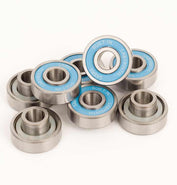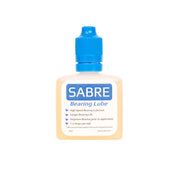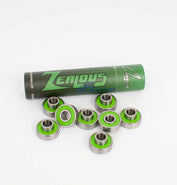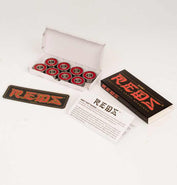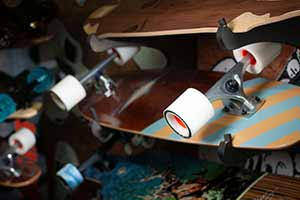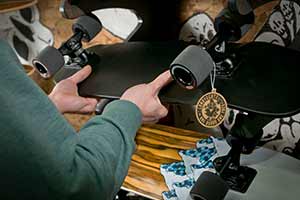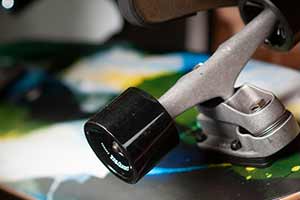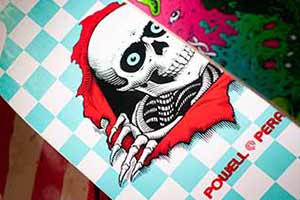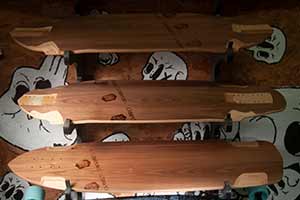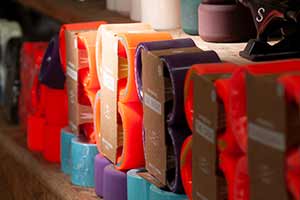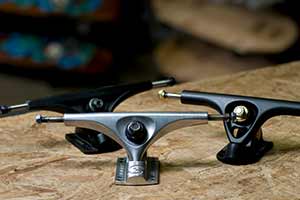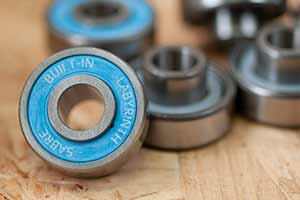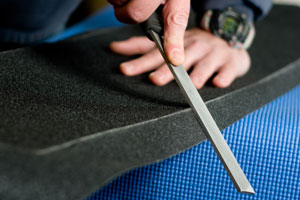What does ABEC rating mean for skateboard bearings?
- Do ABEC ratings matter for skateboarding? TL;DR
- ABEC rating - What does it mean?
- Noise Levels, Clearance, Lubrication - Are they covered by ABEC standards?
- ABEC 1 - Is there a lower grade?
- ABEC 9 - Are they any better than ABEC 1?
- Aggressive Street Skating - Recommended Bearings
- High Precision Bearings - Grades Available
- Alternative standards to the ABEC rating
- How about no-name "ABEC" rated bearings on eBay or Amazon?
- ABEC rated High Precision Bearings - What are they used for?
- Why all the hype about ABEC ratings in skateboarding?
- What do ABEC ratings actually measure?
- Nylon Cages vs Steel Cages
- What does "608" mean for skate bearings?
- What do "Z" and "ZZ" mean on a bearing?
- What does "RS" mean on a skate bearing?
- What does "2RU" mean for skate bearings?
- Results to be expected from using High Precision Bearings
- SUJ2 and SAE52100 - What is the difference?
- How to get more speed from your bearings
Do ABEC ratings matter for skateboarding? TL;DR
A bearing's ABEC rating means almost nothing for skateboarding.
The ABEC rating is designed to measure loads of stuff that doesn't matter for skateboarding, and doesn't cover loads of things that do matter.
The reason you see the ABEC ratings at all in skate shops is because skate companies are lazy and want to sell you stuff.
You are much better off with some decent skate bearings from a well-recognised skate brand that don't have an ABEC rating.
We've also taken the time to bust some skate bearing myths here, which is worth a look if you want to know a bit more.
If you really want the lowdown on exactly what the ABEC rating means, read on...
ABEC rating - What does it mean?
ABEC is an acronym for Annular Bearing Engineering Committee of the AFBMA (Anti-Friction Bearing Manufacturers Association Inc). The ABEC scale of bearings is a set of standards for the manufacturing tolerances of bearings. All quality manufacturers around the world manufacture to at least ABEC 1 standard. If you were to ask your local bearing supplier for a 608ZZ, you would almost certainly receive an ABEC 1 bearing.
What are the grades of bearings available in order, and different are they?
The ABEC rating system goes, from "worst" to "best":
- ABEC 1 Approximately equal to ISO P0
- ABEC 3 Approximately equal to ISO P6
- ABEC 5 Approximately equal to ISO P5
- ABEC 7 Approximately equal to ISO P4
- ABEC 9 Approximately equal to ISO P2
To be honest, you really do not need to waste your money on anything higher than ABEC 1 for skateboarding applications. The ABEC rating only tells us how close the bearings dimensional tolerances are (that is, how close the bearing is to the stated size). There are many other factors relating to the quality of a bearing (shielding, quality of materials, lubrication etc), and most of these factors will have much more of an impact on how fast your skateboard goes than the ABEC Grade of the bearing.
The ABEC rating system covers a few things, but to give you an idea we will just examine one of them - the eccentricity (out of roundness) of the track in the inner ring. For an ABEC 1 (lowest grade) bearing, the maximum eccentricity allowable is 0.0075 mm (0.000295"). This is quite precise - more than precise enough for longboards, cruiser boards and skateboards. The figures for the other ABEC grades are:
- ABEC 3: 0.005 mm (0.000197")
- ABEC 5: 0.0035 mm (0.000138")
- ABEC 7: 0.0025 mm (0.000098")
- ABEC 9: 0.0012 mm (0.000047")
If a bearing is to be used in high precision, high speed machinery, these tiny variations can make a difference to lifespan, vibration, noise and performance. However, skateboards and longboards are very, very far from the clean, shock-free environment of a machine shop. The moment you use a bearing in your board, after 5 - 10 minutes of use the tracks won't just be eccentric, they will become irregular (albeit minutely) enough to be practically indistinguishable from one another. Your high priced ABEC 9 bearing might as well be the cheapest ABEC 1 bearing out there.
Is there a lower grade than ABEC 1 ?
There is no GRADE lower than ABEC 1, but that doesn't mean that a manufacturer has to meet ABEC standards. Loads of cheap bearings out there don't even meet ABEC 1, and manufacturers are under no obligation to meet this standard. Most skate bearings are just bought from a catalogue with a brand name (or whatever name the purchaser requests) stamped or molded into the bearing shield. Some well known skate manufacturers could be buying their bearings from the cheapest, least quality conscious bearing manufacturer, and you would never know. Stick to reputable skate bearing brands that don't make ridiculous marketing claims, and you won't go wrong.
Are there any other standards for measuring Bearing precision?
Yes - the other commonly used standard is the ISO (International Standards Organisation) standard. There are slight differences in the standards applied, but basically ISO Grade P0 is approximately equal to ABEC 1, ISO P6 approximates ABEC 3, ISO P5 approximates ABEC 5, ISO P4 approximates ABEC 7 and ISO P2 approximates ABEC 9. Please see our List of ABEC Grades for the exact values of these precision grades.
What is the purpose of the higher precision bearings, as attained by the ABEC standard?
Higher precision bearings are designed to allow high precision machinery to operate smoother and sometimes at higher speeds than a standard bearing would allow. Keeping this in mind, a standard ABEC 1, 608ZZ is rated with a limiting speed of 32,000 RPM with grease lubrication and 38,000 RPM with oil lubrication. The actual speed that the bearing will attain without failure also depends on the loads applied and other running conditions but there is really no need to go into that too heavily here.
We feel that we must stress here that the purpose of higher precision bearings IS NOT TO GO FASTER, but (amongst other things) to ALLOW HIGH SPEED MACHINERY TO OPERATE AT FASTER SPEEDS THAN STANDARD BEARINGS WILL ALLOW.
What difference is there between ABEC 1 and ABEC 9 in a skateboard?
The most noticeable result is that you will end up with less money in your wallet and the people that sold you the bearings will be eating out at restaurants at your expense for a few days. Under the following conditions, you may notice an improved performance.
- (a) You spend a lot of money (i.e. thousands of pounds/dollars/life credits) to have your equipment (wheels and board) redesigned and manufactured to suit these high precision bearings. You will need to use some type of shock absorber that allows for absolutely no vibration.
- (b) You will have to be prepared to skate on a perfectly smooth surface and make no attempts to use your feet to propel yourself. (Doing so would cause shock loads to the bearings and any extra precision would be lost very quickly).
- (c) After you work out how you are going to achieve the above two criteria, you may (and that is only "may") experience a better result than using ABEC 1 bearings after you attain a speed of about 390 KPH (240 MPH) with 65mm wheels and grease lubrication.
Similar calculations for different wheel sizes and lubrication methods:
- 52mm Wheels Grease Lubricated Bearings 310 kph (195 mph)
- 52mm Wheels Oil Lubricated Bearings 370 kph (230 mph)
- 65mm Wheels Grease Lubricated Bearings 390 kph (240 mph)
- 65mm Wheels Oil Lubricated Bearings 460 kph (290 mph)
- 70mm Wheels Grease Lubricated Bearings 420 kph (260 mph)
- 70mm Wheels Oil Lubricated Bearings 500 kph (310 mph)
The World Speed Record on a skateboard is 91mph (on 80mm+ wheels). You can see that even the lowest ABEC standard is capable of at least twice that! So next time you are feeling like you are being held back by your ABEC 1 bearings pushing around town - think again.
Are the "No-Name" ABEC precision bearings really manufactured to the correct tolerances?
We have to believe that they are until it is proven otherwise.
If the bearings are labelled as ABEC 7 then in most countries the manufacturers of the bearings are compelled by law to provide ABEC 7 bearings. However, we don't know many people how are capable of measuring the difference between and ABEC1 and an ABEC9 bearing! So this is really just about who you want to believe.
What is the meaning of "Z" and "ZZ" in the bearing code? EG "608ZZ"
"Z" is a designation which means a steel shield covering the side of the bearing (for most brands). "ZZ" simply means that the bearing has a shield on both sides.
Normally, the shield itself will be branded as "608 Z" even though there is a shield on both sides of the bearing. This is for practicality in manufacturing. It is much more economical to produce all of the shields stamped as "608 Z" than it would be to manufacture the exact same component with two different stampings on them.
There are two kinds of metal shields - those held on with circlips, and those that are permanently crimped in place. The former is possible to remove with a pair of circlip pliers, and the latter cannot be removed.
"Z" and "ZZ" has nothing to do with the ABEC rating.
You can read about the pros and cons of different bearing shields here.
What does "RS" stand for on a skate bearing? EG 608RS or 6082RS
"RS" simply stands for "Rubber shield." It specifically denotes a "Non Contact" rubber shield, which only contact the outer race - not the inner. Sometimes you will see "2RS" on a bearing code - this simply means that both sides of the bearing have rubber shields.
Keeping your bearings clean is very important to keep them fast. It's much easier to remove a rubber shield than a metal shield - so most good skate bearings will have rubber shields.
In our opinion, the best skate bearings only have a single shield, so you can give them a quick clean without removing anything.
"RS" has nothing to do with the ABEC rating.
You can read about the pros and cons of different bearing shields here.
What does "RU" or "2RU" stand for on a skate bearing? EG 608RU or 6082RU
"RU" is a "Full-Contact" rubber shield, or "Labyrinth" shield (as opposed to an "RS" or "Non-Contact" shield). Here, the shield contacts the inner and the outer bearing races. Similar to "2RS", "2RU" means that a bearing has two shields, one on each side.
"RU" has nothing to do with the ABEC rating.
You can read about the pros and cons of different bearing shields here.
What does "608" mean for skate bearings?
"608" refers to the bearing size. The metric sizing system for bearings is a bit like thread size - each bearing size has a code, eg "6001" and "5307".
For those who need to know, the dimensions of a standard 608 skateboard, longboard or cruiser board bearing are:
| Inner Diameter | 8mm |
| Outer Diameter | 22mm |
| Width | 7mm |
What is the best way to get more speed out of your bearings ?
There's a few things you can do to make your bearings faster.
- The first and most important thing you can do is clean your bearings. You need to try to get them to as close to "as new" condition as possible. A bearing clean and overhaul is where almost all the extra speed is to be had - once they're clean, you're into reducing bearing drag, which makes much less of a difference than cleaning all the dirt out - and to be honest isn't something that most skaters will notice.
- If your bearings have shields on both sides, you can reduce drag by removing one of them. Around 60% of the bearing drag comes from the shields, so removing one of them gets you a relatively huge 30% reduction straight away! This will also make it easier to clean them next time. Make sure when you put your bearings back in your wheels that the shield is on the outside, protecting the balls and races from dirt and moisture.
- Having read this, you might be tempted to remove both shields and go totally "shieldless." Yes, you will reduce bearing drag... but really, the most important thing for bearing speed is that they are clean and free of dirt - bearing drag makes almost no difference to how fast your board rolls. Whilst you might as well remove the inner shield - it's not doing anything anyway - by removing the outer shield as well, you are going to hold back your bearing performance much more than the tiny drag reduction will give you. Don't do it!
You could switch to a ligher skate-specific grease like Bones Speed Cream or Sabre Bearing Lube. Lubricant is responsible for about 30% of the overall drag of a bearing - using a lighter lube will reduce that a fair bit.
It's important to realise that by doing this you will be increasing the frequency with which you need to clean and regrease your bearings. When choosing skate bearing lubricant, you need to choose between:
- High speed bearings, and regular lubing with a very light grease like Bones Speed Cream or Sabre Bearing Lube
- A bit of drag from a heaver grease, but better protection from the elements and hence less regular bearing cleaning.
- The third option is to buy new bearings all the time. This is a bit like wearing brand new socks every day - lovely if you can afford it, but we suspect somewhat impractical for most skaters.
It is not possible to have both high speed and minimal maintenance. We suggest you try both light and heavy grease and see which you prefer. See our skateboard bearing cleaning guide (with video!) for different lubricant recommendations.
Here at Vandem, we are lazy, we can't be bothered to clean our bearings that often, and we don't really think that super-spinning-fast bearings make that much of a difference to our skateboards. So our recommendation is to just bung some thicker grease in there from the outset and put up with a little bit of extra drag whilst not cleaning bearings very often. But it's up to you!
Why is there so much hype about ABEC precision ratings for skateboarding and longboarding?
The short answer is - becuase it's a simple numbering system that's easy for skaters to understand.
Skate companies lie about technical stuff in their marketing all the time. Adhearance to the ABEC bearing standard is not easy to prove or disprove, and it's so deeply ingrained in skate culture that most skaters refuse to believe that it's really not applicable to them. So the legend lives on!
Some friends have bought ABEC 9 bearings and they tell me that it definitely increases speed. Why do they believe this?
We are not psychologists but we can think of 3 reasons immediately. Firstly, if you had just paid several hundred pounds for a set of bearings, you too would "believe" that they were better than what you had bought previously for around £15-£20. Secondly, it's well known that if you really believe that something will make you faster, it probably will (it's all in the mind). Thirdly, how do you seriously compare the speed at which your new ABEC 9 bearings allow you to travel against the speed that your old ABEC 1 bearings allowed you to travel several months ago when they were also new? Are you going to get out the light traps and speed sensors and do timed runs indoors on glass-smooth surfaces? More likely you would be comparing against the speed at which the old ABEC 1 bearings allowed you to travel after they had worn considerably. Try this in reverse. Take out the old ABEC 9 bearings after several months and replace them with new ABEC 1 bearings and you will get a similar increase in speed.
Or maybe you're just imainging it...
What are the best bearings for Aggressive (Street) Skating ?
Again, you will not get any more life out of either high precision or low precision bearings. Aggressive skaters will find that they go through bearings more quickly, so the best advice is "Get the cheapest, as long as they are a decent bearing".
If you are a fan of jumping down stairs and you destroy bearings really often, check out the Bones Big Balls or Bones Super Swiss Six Ball bearings. These have six balls as opoosed to seven, making them a lot stronger and therefore longer lasting.
What is the difference between SUJ2 and SAE52100 bearing steel?
To put it simply, very little difference. They are both standards which are applied to the chemical composition of Chrome Steel (also known as Chromium Steel and High Carbon Chrome Steel). SUJ2 is a Japanese standard, whilst SAE52100 is a U.S. standard.
Both of the above standards are exactly the same for 4 of the 7 major elements used in Chrome Steel. Of the remaining 3 elements the specifications overlap, meaning that an SUJ2 bearing steel is also in many cases conforming to SAE52100 and vice versa. That is not to say that all batches of one will also conform to the other, but the differences are minimal anyway. Don't let anyone tell you that one is better than the other.
The main differences are the specifications for Manganese, Carbon and Molybdenum as follows:
| Manganese | Carbon | Molybdenum | |
| SUJ2 | < 0.50% | 0.95-1.10% | <0.08% |
| SAE52100 | 0.25-0.45% | 0.98-1.10% | <0.10% |
As you can see, the differences are minimal, and they overlap considerably
Are Nylon Cages good for Skateboard bearings?
The "Cage" is the thing that holds the balls in between the bearing races. It acts to keep the bearings evenly spaced and therefore holds the whole bearing together.
Most branded skate bearings have nylon cages, whilst cheaper bearings will have steel cages. Nylon cages are usually used in high speed bearing applications, but for skateboard bearings its a less clear cut advantage.
Nylon cages may have some slight advantages over steel cages in that it could possibly help to dampen the shock loads associated with skating, and it may assist in holding the lubricant in. Honestly though, we'd be suprised if you can tell the difference!
One big advantage of a nylon cage over a steel cage is that nylon cages are easy to remove - so you can completely strip the bearing for a full clean. Steel cages are basically impossible to remove, so you wont be able to dissaemble the bearing and you'll be stuck with a half-arsed cleaning job.
Top Collections

